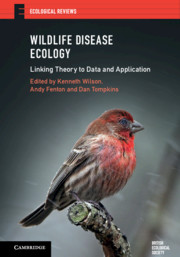Book contents
- Wildlife Disease Ecology
- Ecological Reviews
- Wildlife Disease Ecology
- Copyright page
- Contents
- Contributors
- Preface: Wildlife Disease Ecology
- Glossary of Terms
- Part I Understanding within-host processes
- Chapter one Pollinator diseases: the Bombus–Crithidia system
- Chapter Two Genetic diversity and disease spread: epidemiological models and empirical studies of a snail–trematode system
- Chapter Three Wild rodents as a natural model to study within-host parasite interactions
- Chapter Four From population to individual host scale and back again: testing theories of infection and defence in the Soay sheep of St Kilda
- Chapter Five The causes and consequences of parasite interactions: African buffalo as a case study
- Chapter Six Effects of host lifespan on the evolution of age-specific resistance: a case study of anther-smut disease on wild carnations
- Chapter Seven Sexually transmitted infections in natural populations: what have we learnt from beetles and beyond?
- Part II Understanding between-host processes
- Part III Understanding wildlife disease ecology at the community and landscape level
- Index
- Plate Section (PDF Only)
- References
Chapter Four - From population to individual host scale and back again: testing theories of infection and defence in the Soay sheep of St Kilda
from Part I - Understanding within-host processes
Published online by Cambridge University Press: 28 October 2019
- Wildlife Disease Ecology
- Ecological Reviews
- Wildlife Disease Ecology
- Copyright page
- Contents
- Contributors
- Preface: Wildlife Disease Ecology
- Glossary of Terms
- Part I Understanding within-host processes
- Chapter one Pollinator diseases: the Bombus–Crithidia system
- Chapter Two Genetic diversity and disease spread: epidemiological models and empirical studies of a snail–trematode system
- Chapter Three Wild rodents as a natural model to study within-host parasite interactions
- Chapter Four From population to individual host scale and back again: testing theories of infection and defence in the Soay sheep of St Kilda
- Chapter Five The causes and consequences of parasite interactions: African buffalo as a case study
- Chapter Six Effects of host lifespan on the evolution of age-specific resistance: a case study of anther-smut disease on wild carnations
- Chapter Seven Sexually transmitted infections in natural populations: what have we learnt from beetles and beyond?
- Part II Understanding between-host processes
- Part III Understanding wildlife disease ecology at the community and landscape level
- Index
- Plate Section (PDF Only)
- References
Summary
Why do hosts vary so much in parasite burden, how does this variation translate to variation in host demographic rates and parasite transmission, and how does varied transmission intensity impact selection upon immune defence of individuals? The theoretical foundations of disease ecology provide predictions for the answers to these questions, yet testing such predictions with empirical data poses many challenges. We show how the long-term ecological and genetic study of the unmanaged Soay sheep of St Kilda has addressed fundamental questions in disease ecology, with longitudinal data on parasite burden, immune defence, condition, survival, and fecundity of >10,000 individuals. The rich individual-scale data are complemented by >30 years of data on sheep population dynamics and genetic diversity as well as parasite dynamics and diversity. Population-scale work has documented the range of parasite species present and the contribution of the most prevalent and virulent parasites to regulating sheep dynamics. Individual-scale work has identified drivers of variation in parasite burden and tested hypotheses about costs and benefits of defence in a quest to determine how natural selection has shaped immune function of the sheep.
Keywords
- Type
- Chapter
- Information
- Wildlife Disease EcologyLinking Theory to Data and Application, pp. 91 - 128Publisher: Cambridge University PressPrint publication year: 2019
References
- 2
- Cited by



